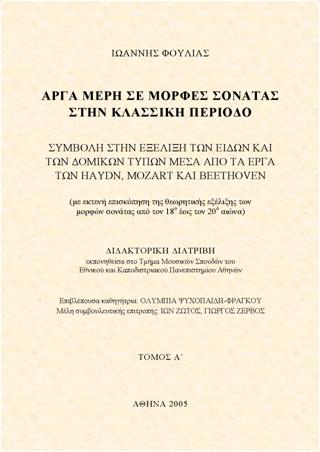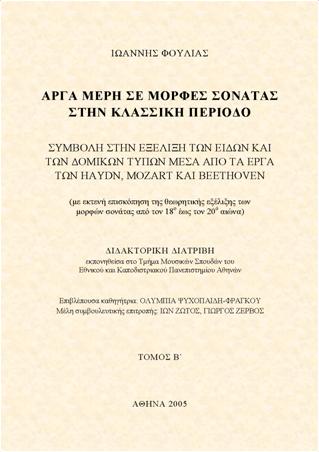Ioannis Fulias,
Slow movements in sonata forms in the classic era. A contribution to the evolution of genres and structural types through the works of Haydn, Mozart, and Beethoven (with
an extensive survey of the theoretical evolution of sonata forms from 18th to 20th centuries), Doctoral
dissertation (National and Kapodistrian University of Athens / Department of Musical Studies),
Athens 2005 [2 volumes,
xvi + 781 pages].
 Ιωάννης
Φούλιας, Αργά μέρη σε μορφές σονάτας στην κλασσική περίοδο. Συμβολή στην εξέλιξη των ειδών
και των δομικών τύπων μέσα από τα έργα των Haydn, Mozart και Beethoven (με εκτενή επισκόπηση της
θεωρητικής εξέλιξης των μορφών σονάτας από τον 18ο έως τον 20ό αιώνα), Διδακτορική
διατριβή (Τμήμα Μουσικών Σπουδών του Εθνικού και Καποδιστριακού Πανεπιστημίου Αθηνών),
Αθήνα 2005 [2 τόμοι, xvi + 781 σελίδες].
Ιωάννης
Φούλιας, Αργά μέρη σε μορφές σονάτας στην κλασσική περίοδο. Συμβολή στην εξέλιξη των ειδών
και των δομικών τύπων μέσα από τα έργα των Haydn, Mozart και Beethoven (με εκτενή επισκόπηση της
θεωρητικής εξέλιξης των μορφών σονάτας από τον 18ο έως τον 20ό αιώνα), Διδακτορική
διατριβή (Τμήμα Μουσικών Σπουδών του Εθνικού και Καποδιστριακού Πανεπιστημίου Αθηνών),
Αθήνα 2005 [2 τόμοι, xvi + 781 σελίδες].
Supervisors: Olympia Psychopedis-Frangou,
Ion Zottos, George Zervos
Full text (in pdf format)
Abstract in English
This study is
divided in three extensive chapters with equal in amount main targets:
In the first chapter, the examined repertoire is firstly presented systematically and chronologically: 106 symphonies, 19 concertos, 68 string quartets, 26 string trios, 39 piano trios, 13 works for keyboard and other instruments, and 57 piano sonatas by Haydn; 54 symphonies, 39 concertos, 39 chamber works for strings, 9 works for wind and strings, 46 works for piano and other instrument(s), and 26 piano sonatas by Mozart; 9 symphonies, 8 concertos, 24 chamber works for strings, 10 works for wind and strings, 30 works for piano and other instrument(s), and 38 piano sonatas by Beethoven.
Thereafter, each musical genre is put under assiduous investigation, in order to be demonstrated under which circumstances (specific genre, number of movements, particular period of time, or personal preferences) a slow movement is included or not, as well as in which position it is presented. Thus, it is obvious that for some genres of the classic era Haydn, Mozart, and Beethoven could choose rather typical dispositions of movements, whereas in other genres the three composers had much wider possibilities to apply more experimental orders. The tonality of a slow movement is discussed in a first appendix of this chapter, while in a second appendix is proposed a typology for movements that are directly connected with the following one.
The second chapter is dedicated to an extensive survey of the theoretical evolution of sonata forms from 18th to 20th centuries. First of all, five main structural types of sonata are distinguished:
(a) the ternary sonata form, with exposition, development (Durchführung), recapitulation (and, optionally, a coda);
(b) the binary sonata form, with exposition and a “second macrostructural unity”, consisting in a “developmental section” and a return in the main key of only the subordinate and closing theme group;
(c) the sonata form without development, which has only exposition and (full) recapitulation;
(d) the sonata-rondo form, which increase the ternary sonata form adding a tonic return of the main theme before the central development;
(e) the sonata-concerto form that is divided in three subtypes, i.e. the ternary sonata-concerto form, the binary sonata-concerto form and the sonata-concerto form without development, all of which combine the plain types of sonata (in the “solos”) with a number of orchestral ritornellos (the “tuttis”).
The evolution of these sonata forms is reconstructed through handbooks of composition from 18th and early 19th centuries
(by Scheibe, Quantz, Riepel,
Vogler, Koch, Galeazzi,  Daube, Reicha, Birnbach and Czerny, among others), handbooks of composition or analysis from 19th and 20th centuries (by A. B. Marx, Lobe, Prout,
Riemann, Leichtentritt, Goetschius, Schönberg, Ratz, Berry, Kohs, Kühn, Caplin etc) as well as musicological studies from the early 20th century to our days (by
W. Fischer, Tobel, Girdlestone,
Ratner, Larsen, Simon, Tischler, Newman, Longyear, Weising, Ruile-Dronke,
Heimes, Dahlhaus, Rosen, Somfai, Küster, Brück, Webster, Hepokoski and others). This process results in a wide store of harmonic and thematic characteristics
and possibilities as well as of several compositional techniques that were in use in the classic (and the romantic, also) era. Special emphasis is put on matters of
terminology, on parallels and differences that are observed among theoretical sources of the same period or among different historical periods, and on a constant critical
annotation of the contents of these theoretical sources with the assistance of secondary bibliography.
Daube, Reicha, Birnbach and Czerny, among others), handbooks of composition or analysis from 19th and 20th centuries (by A. B. Marx, Lobe, Prout,
Riemann, Leichtentritt, Goetschius, Schönberg, Ratz, Berry, Kohs, Kühn, Caplin etc) as well as musicological studies from the early 20th century to our days (by
W. Fischer, Tobel, Girdlestone,
Ratner, Larsen, Simon, Tischler, Newman, Longyear, Weising, Ruile-Dronke,
Heimes, Dahlhaus, Rosen, Somfai, Küster, Brück, Webster, Hepokoski and others). This process results in a wide store of harmonic and thematic characteristics
and possibilities as well as of several compositional techniques that were in use in the classic (and the romantic, also) era. Special emphasis is put on matters of
terminology, on parallels and differences that are observed among theoretical sources of the same period or among different historical periods, and on a constant critical
annotation of the contents of these theoretical sources with the assistance of secondary bibliography.
In the third chapter, 373 slow movements in any sonata form by Haydn, Mozart, and Beethoven are analysed, in a way that does not leave open any critical question about their macrostructure and at the same time allows to be revealed many idiosyncratic features in several of these. In a second level, partly conclusions are drawn from the analysis of the works by Haydn from early 1750s to 1760/1761, from 1761 to 1765, from 1766 to 1772, from 1773 to 1781, from 1782 to 1791, and from 1791 to 1803; as far as Mozart is concerned, five creative periods are distinguished (1761-1768, 1769-1774, 1775-1780, 1781-1785, and 1786-1791), whereas Beethoven’s works are distributed in four periods (1782-1792, 1793-1802, 1802-1814, and 1815-1826). Finally, the gathering of all these data leads to a holistic speculation about the evolution of sonata forms in the slow movements of the instrumental works by Haydn, Mozart, and Beethoven.
From the many significant conclusions of this dissertation, here can be mentioned that sonata forms find application in at least 60% of slow movements of the classic era, as well as that the supposed “slow-movement sonata form” par excellence (according Rosen), i.e. the sonata form without development, constitutes in general only the third (!) structural choice in the frame of sonata forms in slow movements of these three great composers.
© Ioannis Fulias